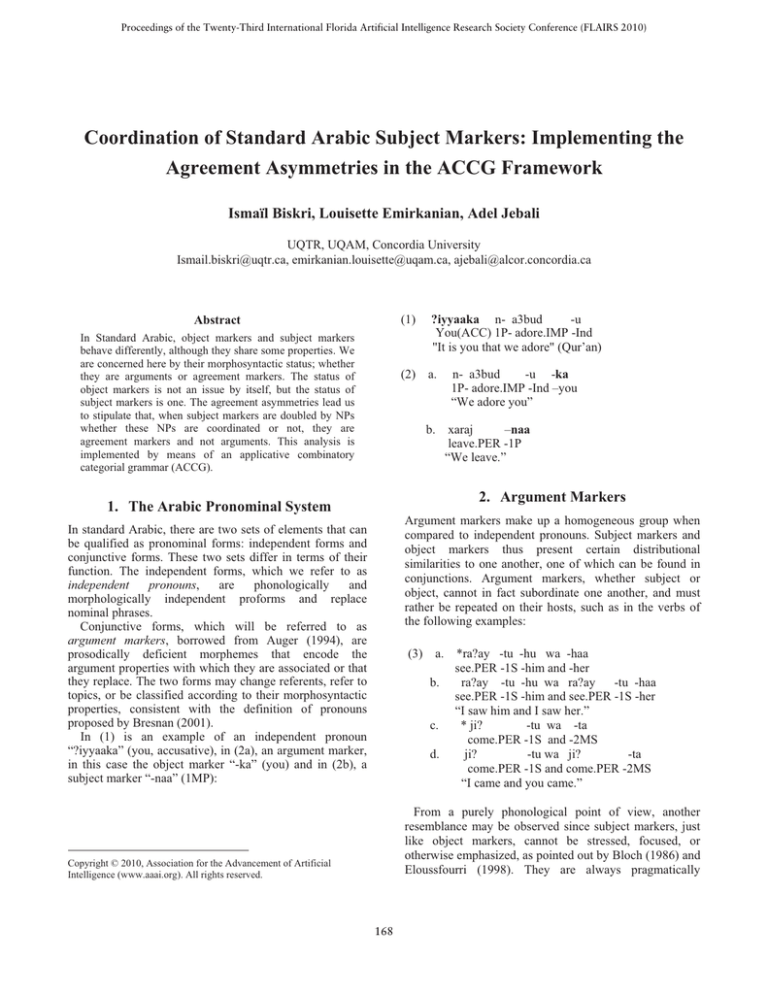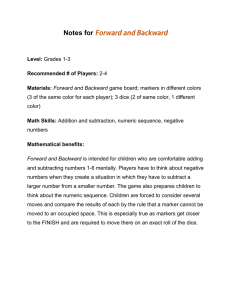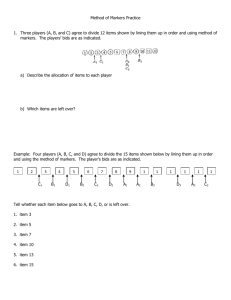
Proceedings of the Twenty-Third International Florida Artificial Intelligence Research Society Conference (FLAIRS 2010)
Coordination of Standard Arabic Subject Markers: Implementing the
Agreement Asymmetries in the ACCG Framework
Ismaïl Biskri, Louisette Emirkanian, Adel Jebali
UQTR, UQAM, Concordia University
Ismail.biskri@uqtr.ca, emirkanian.louisette@uqam.ca, ajebali@alcor.concordia.ca
Abstract
In Standard Arabic, object markers and subject markers
behave differently, although they share some properties. We
are concerned here by their morphosyntactic status; whether
they are arguments or agreement markers. The status of
object markers is not an issue by itself, but the status of
subject markers is one. The agreement asymmetries lead us
to stipulate that, when subject markers are doubled by NPs
whether these NPs are coordinated or not, they are
agreement markers and not arguments. This analysis is
implemented by means of an applicative combinatory
categorial grammar (ACCG).
(1)
?iyyaaka n- a3bud
-u
You(ACC) 1P- adore.IMP -Ind
"It is you that we adore" (Qur’an)
(2)
a.
n- a3bud
-u -ka
1P- adore.IMP -Ind –you
“We adore you”
b. xaraj
–naa
leave.PER -1P
“We leave.”
2. Argument Markers
1. The Arabic Pronominal System
Argument markers make up a homogeneous group when
compared to independent pronouns. Subject markers and
object markers thus present certain distributional
similarities to one another, one of which can be found in
conjunctions. Argument markers, whether subject or
object, cannot in fact subordinate one another, and must
rather be repeated on their hosts, such as in the verbs of
the following examples:
In standard Arabic, there are two sets of elements that can
be qualified as pronominal forms: independent forms and
conjunctive forms. These two sets differ in terms of their
function. The independent forms, which we refer to as
independent
pronouns,
are
phonologically
and
morphologically independent proforms and replace
nominal phrases.
Conjunctive forms, which will be referred to as
argument markers, borrowed from Auger (1994), are
prosodically deficient morphemes that encode the
argument properties with which they are associated or that
they replace. The two forms may change referents, refer to
topics, or be classified according to their morphosyntactic
properties, consistent with the definition of pronouns
proposed by Bresnan (2001).
In (1) is an example of an independent pronoun
“?iyyaaka” (you, accusative), in (2a), an argument marker,
in this case the object marker “-ka” (you) and in (2b), a
subject marker “-naa” (1MP):
(3)
a. *ra?ay -tu -hu wa -haa
see.PER -1S -him and -her
b.
ra?ay -tu -hu wa ra?ay -tu -haa
see.PER -1S -him and see.PER -1S -her
“I saw him and I saw her.”
c.
* ji?
-tu wa -ta
come.PER -1S and -2MS
d.
ji?
-tu wa ji?
-ta
come.PER -1S and come.PER -2MS
“I came and you came.”
From a purely phonological point of view, another
resemblance may be observed since subject markers, just
like object markers, cannot be stressed, focused, or
otherwise emphasized, as pointed out by Bloch (1986) and
Eloussfourri (1998). They are always pragmatically
Copyright © 2010, Association for the Advancement of Artificial
Intelligence (www.aaai.org). All rights reserved.
168
neutral and only their independent equivalents may be
stressed.
However, argument markers present several differences
that allow them to be split into two distinct groups. Among
these differences, there are several of particular importance
for the hosts. Object markers may appear on several types
of hosts (verbs, prepositions, nouns and functional heads)
while subject markers have only one possible host: the
verb. Furthermore, purely morphologically speaking, only
subject markers are included in the morphological
boundaries of their hosts while object markers are excluded
and agglutinate to already morphologically well-formed
words.
These resemblances and these differences lead us to
question the morphosyntactic status of these markers: are
they argument markers or agreement markers? In order to
answer this question, it is necessary to observe the
behaviour of these units in contexts where they co-occur
with independent pronouns and noun phrases.
Example (5a) illustrates doubling of the subject marker –
at (3FS) by an NP while example (5b) illustrates the
impossibility of doubling of an object marker, here –hu
(him).
(5)
Observe that only subject markers may be doubled by
NPs, and (5b) with the object marker is ungrammatical. In
the case of the object marker, only the dislocated form is
possible (4a). Moreover, and this is particularly
interesting, the doubling in the case of the subject marker
has an effect on the agreement. As can be seen in (5a), the
agreement is only made in terms of gender. It is therefore
a case of impoverished agreement. The dislocation links
these two types of units since the agreement is made in
gender and number (rich agreement) (in (4a) and (4b)), as
much for subject markers as for the object markers.
Bresnan and Mchombo (1986) distinguish two types of
agreement: grammatical agreement and anaphoric
agreement. In grammatical agreement between an NP and
a subject marker, the NP is the argument of the verb while
the marker redundantly expresses the person, the number
and the gender of this NP. In anaphoric agreement, on the
other hand, the marker is an incorporated pronominal
argument and the co-referential NP is therefore not an
argument; it functions as a focus or topic of the
proposition or of the discursive structure. The authors
provide several tests to distinguish between these two
types of agreement, such as locality, the status (peripheral
vs central) of the NP co-indexed with the marker, and the
membership of the language under study to a given type.
These tests, particularly that of locality (grammatical
agreement is always local) 1 lead us to conclude that object
markers are arguments since they are never doubled and
the only agreement relations they exhibit are of the
anaphoric type and non-local by definition (the same
definition as for dislocation). Where subject markers are
concerned, these tests lead us to conclude that they present
a functional ambiguity: depending on the context, they
may be agreement markers or arguments. It was therefore
warranted to take a closer look at the data to decide if it
was a case of grammatical agreement or anaphoric
agreement. It was consequently appropriate to examine the
conjoined structures that introduce, in a certain way, an
extra level of agreement.
3. The Status of Argument Markers
Let us first clarify what we mean by agreement marker
and argument marker. We define the agreement marker as
an element devoid of a proper syntactic function. This
element refers to another with which it shares certain
grammatical features in a given configuration (Auger,
1994). The agreement marker is therefore usually part of a
word (or a phrase) that itself satisfies a syntactic function.
We define a syntactic argument here as being a
linguistic object selected by, and so complement of,
another constituent.
There are several contexts that allow us to address the
question of the morphosyntactic status of argument
markers. The cases of interest are either those of doubling
or dislocation. Even if the dislocation is tied in with the
doubling in terms common features, it is distinguished by
an intonational break (or pause) which places the
dislocated element in a peripheral position that produces
certain pragmatic effects, such as emphasis.
The following examples illustrate cases of dislocation
and doubling. In (4a), the dislocation involves the object
marker –hu (him) and, in this type of dislocation, the NP
dislocated to the left is in the nominative. In (4b), the
dislocation involves the subject marker –uu (3MP). As
with the previous example, the NP dislocated to the left is
in the nominative.
(4)
a. jaa?
-at ?al- banaat -u
come.PER -3F the- girls -NOM
"The girls came."
b. *ra?ay -tu -hu ?al- walad -a
see.PER -1S -him the- boy –ACC
a. ?ar- rajul -u
ra?ay -tu -hu
the- man -NOM see.PER -1S -him
“The man, I saw him.”
b. ?ar- rijaal -u
jaa?
-uu
the- men -NOM come.PER -3MP
"The men, they came."
1
See (Jebali, 2009) for application of these tests and the
empirical details.
169
features), as was the case with the dislocated structures in
(6).
4. Coordination
Our objective was not to account for coordinate structures
as such. We were interested rather in the asymmetries of
the agreement.
Take the schema VSm NP and NP 2 . Theoretically, it is
possible that the agreement be made in gender and number
with the sum of the values of the conjuncts. This is what
we find in the case of the dislocation in (6) for example 3 :
(6) jaa?
-aa, ?al- bint -u
wa l- walad
-u
come.PER -3MD, the- girl -NOM and the- boy
-NOM
“They came, the girl and the boy.”
(8)
-u
*jaa?
-a
?al- banaat -u
come.PER -3M the- girls
-at al- banaat -u
wa al- ?awlaad
leave.PER -3F the- girls -NOM and the- boys
-NOM
“The girls and the boys left.”
Moreover, when the first conjunct is an independent
pronoun, the agreement made with it is rich (gender and
number), illustrated in the following example:
(9) xaraj
-na hunna
wa al- ?awlaad
-u
leave.PER -3FP they(FP-NOM) and the- boys
-NOM
“They (FP) left, they (FP) and the boys.”
This corresponds with what we find in the case of a
dislocation without coordination (4b), where the
agreement is made in both gender and number.
Another possibility would be for the agreement to be
impoverished (as we found in the case of non-coordinated
reduplication), but still agreeing in terms of gender with
the sum of the conjuncts.
(7)
-u
xaraj
With regards to the difference between independent
pronouns and an NP, we may call on what has been
proposed by several authors, such as Harbert and Bahloul
(1992) and, with certain nuances, Bouchard (2002):
pronouns inherently encode number while nouns acquire
this feature in context. It is therefore not surprising that
the pronoun, when it is the first conjunct, entails an
agreement in gender and number, while the NP entails an
impoverished agreement, only in gender.
Other work, namely Aoun et al. (1994, 1999), addresses
the question by stipulating that coordination in Arabic is
phrasal. It is thus proposed that the structure is VSm NP
[and NP], which would explain how the agreement is only
made with the first agreement. However, these authors
examined this question by stressing contemporary Arabic
dialects (especially Moroccan Arabic and Lebanese
Arabic), which limits the extension of their analysis to
Standard Arabic. Moreover, they do not establish the
differences between doubling and dislocation (especially
with independent pronouns) 5 .
The data on coordinate structures, whatever the analysis
adopted to account for coordination in Arabic, show us
that subject markers enter into the same type of
impoverished agreement relationship in the case of
doubling as the postposed nominal, be it a single element
or two coordinated elements.
In light of the tests proposed by Bresnan and Mchombo
(1986) to account for the anaphoric agreement/
grammatical agreement opposition on the one hand, and
on the other hand, the behaviour of subject markers in a
wa l- ?awlaad
-NOM and the- boys
–NOM
The Standard Arabic data, with regards to the type of
doubling of interest here, place us before a particular
agreement. Indeed, on the one hand, while the first
conjunct is an NP, the agreement is not made with sum of
the values of the two conjuncts, but only with the first
conjunct; on the other hand, this agreement with the first
conjunct is impoverished (gender agreement only, just as
in contexts without coordination). If Standard Arabic and
the dialects of Arabic’s data 4 differ in terms of agreement
in gender and number, the fact that in a coordinate
structure, agreement is only made with the first conjunct
should be found in the two varieties (Aoun et al., 1994,
1999).
The following example illustrates this particular
behaviour. Here, the subject marker –at (3F) attached to
the verb xaraj (to go out) agrees only in gender with the
first conjunct al-banaatu (the girls) remaining in the
singular form, therefore not agreeing with the sum of the
values of the two conjuncts (two plurals, one of which
being masculine should have given an agreement with the
plural masculine, carrying out a calculation of the
2
V: verb, Sm: subject marker.
As we can see, the marker is dual masculine, since in
Standard Arabic the masculine overrides the feminine.
4
In the non-coordinated cases, as in (5a), in Arabic
dialects, the marker would be in plural.
3
5
170
We hope to address this question in future work.
doubling context (with coordinate NPs or not), we can
conclude that they are indeed agreement markers. 6
(Steedman, 2000) and German with LEXGRAM, etc., new
languages are also becoming influenced by a trend of
categorial grammars. The most recent work includes
exploratory analyses for non-Indo-European languages,
such as relative constructions in Turkish (Bozsahin, 2002),
complement forms in –te in Japanese (Kubota, 2007) and
nominal phrases in Arabic (Anoun, 2006).
For the purposes of our instantiation, we use the
Applicative Combinatory Categorial Grammar model. In
this model, linguistic units, at the level of morphosyntactic
structures, are considered to be operators or operands and
are translated at the level of predicative structures in
formal logical expressions of combinatory logic (Curry,
1958; Shaumyan, 1998). As well as verifying the
soundness of syntactic connections of utterances, this
model permits, by way of formal rules, the explicit
connection between morphosyntax to its predicative
representation. Several rules are presented below. The
premise of each rule is the concatenation of linguistic units
with categorial types. The consequence of each rule is an
expression of a typical applicative with the possible
introduction of a combinator.
5. Implantation by means of an applicative
combinatory categorial grammar
The categorial grammar model is founded on explicit
logical rules, substituting a purely surface linguistic
analysis for an inferential logical calculation. Relying more
on the notion of surface structure, it leads to a logical form
in order to express meaning. This model has the advantage
of being able to represent the intricacies of phrasal units by
way of the operation of the application of an operator to its
operand, a universal representation itself. Somewhat
forgotten since Husserl (the concepts of categorems and
syncategorems), Lesniewski (semantic categories),
Adjukiewics, Bar-Hillel and Lambek (Lambek’s calculus),
the 70s, 80s and 90s witnessed a veritable explosion of
work and research in the domain of Categorial Grammars.
The “collective” can be dubbed “Flexible Categorial
Grammars”, represented by Montague’s model of
Universal Grammar for a categorial syntax and
denotational semantics, by Steedman’s Combinatory
Categorial Grammar associating a categorial syntactic
analysis and a construction of functional semantics
interpretation by way of lamda-calculation, by Harris’
operator-operand
grammar,
by
the
Applicative
Combinatory Categorial Grammar with the addition of
metarules to direct the rules of type-raising and
composition (Biskri, Desclés, 2006), as well as other
generalizations from Lambek’s calculus. Among the most
recent developments, we find a multimodal version of
Combinatory Categorial Grammars (Baldridge, Krujiff,
2003) that introduce modalities and restrictions on the
operability of categorial rules in order to eliminate cases of
ambiguity, or even the Abstract Categorial Grammar
model (De Groote, Podogalla, 2004) to describe syntax and
semantics.
Putting aside the differences between these approaches and
applications, there are three things that stand out in
particular in all these models: (i) their use of logical and
mathematical methods to account for language, especially
semantics; (ii) their distinction of several logical levels of
representation of languages including at the very least a
linear structure of the observable level and a operatoroperand structure of the construction level. This distinction
is occasionally erroneously confused with the standard
theory expounded by Chomsky, which is far from
explicitly recognizing logical levels other than deep
structure (Steedman, 2000); (iii) their flexibility and
adaptability to several languages. In keeping with French,
English (Biskri, Desclés, 2006; Steedman, 2000), Dutch
Rules of
Application
Rules of type
change
Rules of functional
composition
[X/Y : u1] [Y : u2]
>
[X : (u1 u2)]
;
[X : u]
>T
[Y/(Y\X) : (C* u)]
[Y : u1] [X\Y : u2]
<
[X : (u2 u1)]
[X : u]
;
<T
[Y\(Y/X) : (C* u)]
[X/Y : u1] [Y/Z : u2]
[Y\Z : u1] [X\Y : u2]
>B ;
<B
[X/Z : (B u1 u2)]
[X\Z : (B u2 u1)]
The combinators B and C* are associated to introduction
and deletion rules (-reduction) which are the following
(U1, U2, U3, U4 being typical applicatives that behave
either as operators or operands):
Let us show, now, how we can give an account, by
means of ACCG, of markers of arguments in Arabic and
more particularly subject markers and the coordination of
subject markers. The major challenge is the addition of
morphological information on gender and number to
categories.
na3bud -u ka
--------------------(S/Ns)/No
S\(S/No1sm)
(S/No)/((S/Ns3sm)/No)
---------------------------------------->
S/No
---------------------------------------------------------------<
S
Note that Ns (respectively No) is a class name acting as a
subject (object, respectively). Within the statement (2.a),
6
Subject markers behave like arguments in the other
contexts and therefore enter into an anaphoric relation.
171
Category Ns3sm typifies a noun acting as subject of 3rd
person masculine singular. No1sm typifies a noun acting as
object of 1st person singular masculine.
-haa are of different categories. The first marker refers to
an object of masculine gender while the second refers to an
object of feminine gender.
The categorial analysis of the statement (3.a) fails when
we apply coordination. Indeed, the object markers -hu and
*ra?ay
---------(S/Ns)/No
-tu
----(S/No)\((S/Ns1sm)/No)
-hu
wa
-haa
--------------S\(S/No3sm)
(X\X)/X
S\(S/No3sf)
----------------------------------------------- fails
The repetition of the verb ra?ay in (3.b) is necessary for
coordination to be possible. Coordination is applied, in this
case, to two sentences.
ra?ay
-tu
-hu
-----------------S\(S/No3sm)
(S/Ns)/No (S/No)\((S/Ns1sm)/No)
----------------------------------------------<
(S/No)
--------------------------------------------------------------->
S
wa
----(X\X)/X
ra?ay
------(S/Ns)/No
-tu
-------(S/No)\((S/Ns1sm)/No)
–haa
-------------S\(S/No3sf)
----------------------------------------------<
(S/No)
----------------------------------------------------------------->
S
---------------------------------------------------------------------------------------------------(X\X)/X
S
The categorial analysis of the statement (3.c) fails when
we apply coordination to subject markers -tu and –ta.
These are, indeed, associated with different respective
categories that denote that –tu refers to a subject of the 1st
person while -ta refers to a subject of the 2nd person.
In the case of Example (8) -at is considered as an
operator which operates on the verb xaraj in order to
construct a complex operator whose operand is a subject of
the 3rd person and of feminine gender.
In the case of the example (9) -na is considered as an
operator which operates on the verb xaraj in order to
construct a complex operator whose operand is a subjectpronoun of feminine gender and of the 3rd plural person.
As for (3.b), the repetition of the verb ji? in (3.d) is
necessary for coordination to be possible. Coordination is
applied to two sentences. This applies to both expressions’
sentence patterns.
* ji?
-----S/Ns
Xaraj -at
al-banaat-u
wa
al-awlaad-u
------ ------------------ -----------------(X\X)/X Ns3mp
S/Ns (S/Ns3f)\(S/Ns) Ns3fp
-----------<T
S\(S/Ns3fp)
--------------------------------<B
S\(S/Ns)
-----------<T
S\(S/Ns3mp)
--------------------------------------------------- (X\X)/X
S\(S/Ns3mp)
------------------------<
S
-tu
wa
-ta
------------S\(S/Ns1sm)
(X\X)/X S\(S/Ns2sm)
--------------------------------------------fails
ji?
-tu
wa
ji?
-ta
------ ------------- ----(X\X)/X S/Ns S\(S/Ns2sm)
S/Ns S\(S/Ns1sm)
-----------------------<
S
----------------------<
S
------------------------------------------------------------(X\X)/X
S
172
AUGER, J. (1994). Pronominal Clitics in Québec
Colloquial French : A Morphological Analysis. PhD
dissertation, University of Pennsylvania, Philadelphia.
BAHLOUL M., HARBERT W. (1992). « Agreement
Asymmetries in Arabic ». In « The Eleventh West Coast
Conference on Formal Linguistics », vol. 11, pp. 15–31.
BALDRIDGE J., KRUIJFF G.J. (2003). Multi-Modal
Combinatory Categorial Grammar.
EACL 2003
Proceedings.
BISKRI I., DESCLÉS J.P. (2006). Coordination de
Catégories Différentes en Français. Faits de Langue No 28.
BLOCH, A. (1986). Studies in Arabic Syntax and
Semantics. Wiesbaden : O. Harrasowitz.
BOUCHARD, D. (2002). Adjectives, Number and
Interfaces : Why languages vary ? North-Holland:
Elsevier.
BOZSAHIN, C. (2002). The Combinatory Morphemic
Lexicon . Computational Linguistics, 28(2):145-186.
BRESNAN, J. (2001). ”The Emergence of the Unmarked
Pronoun”. In Geraldine Legendre, Jane Grimshaw et Sten
Vikner
(éditeurs),
”Optimality-theoretic
Syntax”,
Massachusetts : MIT Press, pp. 113–142.
BRESNAN J., MCHOMBO S.A. (1987). ”Topic, Pronoun
and Agreement in Chichewa”. Language, vol. 63, no 4, pp.
741–782.
CURRY B.H., FEYS, R. (1958). Combinatory Logic Vol.
I. Amsterdam: North-Holland.
DE GROOTE, P., PODOGALLA, S. (2004). On the
expressive power of Abstract Categorial Grammars:
Representing context-free formalisms. In Journal of Logic
and Information.
DESCLÉS J.P. (1996). Cognitive and Applicative
Grammar : an Overview. C. Martin Vide, ed. Lenguajes
Naturales y Lenguajes Formales XII, 29-60.
ELOUSSFOURRI, E. (1998). Les pronoms personnels de
l’arabe : syntaxe interne et externe. PhD dissertation,
Université Paris VIII.
ENGELMORE, R., and Morgan, A. eds. 1986. Blackboard
Systems. Reading, Mass.: Addison-Wesley.
JEBALI, A. (2009). La modélisation des marqueurs
d’Arguments de l’arabe standard dans le cadre des
grammaires à base de contraintes. PhD dissertation.
Université du Québec à Montréal, Canada.
KUBOTA, Y., (2007), A Multimodal Combinatory
Categorial
Grammar
analysis
of
–te
form
complementation. Colloque de syntaxe et sémantique.
Paris.
SHAUMYAN S.K. (1998). Two Paradigms of Linguistics :
The Semiotic Versus Non-Semiotic Paradigm. Web
Journal of Formal, Computational and Cognitive
Linguistics.
STEEDMAN M. (2000). The Syntactic Process. MIT
Press/Bradford Books.
Xaraj -na
------ ----S/Ns (S/Ps3fp)\(S/Ns)
hunna
wa
al-awlaad-u
-------- -------------------Ps3fp
(X\X)/X Ns3mp
-------<T
S\(S/Ps3fp)
---------------------------------<B
S\(S/Ns)
----------<T
S\(S/Ns3mp)
------------------------------------------------(X\X)/X
S\(S/Ns3mp)
---------------------------<
S
6. Conclusion
We have shown that the behavior of argument markers
changes according to whether they appear in a dislocation
or a doubling configuration. In the first case, we observe a
rich agreement whether we be in the presence of a subject
or an object marker. In the second case, on the one hand,
the doubling is only possible with subject markers and, on
the other hand, the resulting agreement is impoverished.
Thus we are in presence of a type of grammatical and nonanaphoric agreement, and the subject markers in this case
are agreement markers, whether the NPs are coordinated or
not. An implementation by means of the applicative
combinatory categorial grammar has been done. We have
proved that in the general framework of categorial
grammars it is possible to give an account for the analysis
of argument markers in Arabic. We believe that the
analysis of Arabic cannot be done without an account for
the morphological phenomena. While only a few attempts
integrate morphology to categorial analysis and were
strongly criticized, our implementation does this and our
results show that we are able to conceptualize the
information relating to gender, number and person in
categorical types. We have now to decide on which
structure to adopt for coordination (phrasal or not) and
consider if, as Aoun et al. (1994, 1999) have proposed, it
can explain the agreement with the first conjunct when the
NPs are coordinated.
References
ANOUN, H. (2006). “Towards a logical analysis of
nominal sentences in standard Arabic”, ESSLLI ‘06.
AOUN J., BENMAMOUN E., SPORTICHE D. (1994).
“Agreement, Word Order, and Conjugation in Some
Varieties of Arabic”. Linguistic Inquiry, vol. 25, no 2, pp.
195–220.
AOUN J., BENMAMOUN E., SPORTICHE D. (1999).
”Further Remarks on First Conjunct Agreement”.
Linguistic Inquiry, vol. 30, no 4, pp. 669–681.
173





